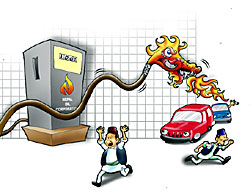Over the last 15 years since reforms began we have seen the 'consumer' benefiting through the opening of aviation, banking, insurance and other sectors. We have learnt to pay extra for better services and choice. We pay the highest tariffs for electricity and surely making services efficient will actually avoid future hikes. Similarly, a hit taken on petroleum products prices and introduction of well regulated market forces will actually make Nepali consumers not subsidising the inefficiencies of Nepal Oil Corporation. Like we have stopped to a large extent shouldering the costs of inefficiencies of RNAC we will slowly have to extend it to other sectors also.

Economists tell us the exchange rate and inflation are linked. It is more about inflation determining the currency exchange rate and not vice-versa. However, Nepal's situation is peculiar. Our currency is directly pegged to the Indian Rupee through a mechanism of a fixed exchange rate which is politics rather than determined by economics. Therefore, as long as the Indian Rupee does not
depreciate, the impact of inflation will not be felt. With the Indian economy growing at 8%, the chances of Indian rupee depreciating is very slim and therefore we are to a certain extent insulated.
It is becoming increasingly important for Nepal to understand the impact of the fixed exchange rate on the economy. While most people talk about the Nepali rupee depreciating against the Indian rupee, I have not seen any analysis that convinces me about it. In contrary, no one has explored the appreciation of the Nepali rupee against the Indian rupee.
The fixed exchange rate has been established taking into consideration that the Nepali trade basket is dominated by bilateral trade. However, over the years, Nepal is earning foreign exchange that is nearly a quarter of its GDP. The correction of the same in the exchange rate is long overdue.
Just going by pure mathematics, a drop of exchange rate with India to 1.30 instead of 1.60 would wipe out all inflationary impact. In nominal terms, fuel prices would be cheaper than what we are paying in Nepali Rupee terms. This would make our imports cheaper, so what dollars we have as reserves would be able to sustain more months of exports.
In the interest of the economy this mathematics should be made to work.I am sure there will be many who would disagree with this, but the Nepali public has a right to demand explanation on the exchange rate logic.
Economists inside government outside government, banking community and others please come out and explain. For the political parties who still feel they have a chance of governing sometime in the future, instead of burning tyres let us begin this debate.
www.arthabeed.com



